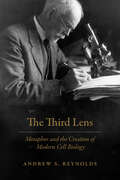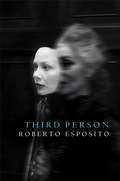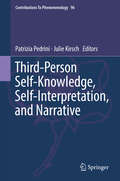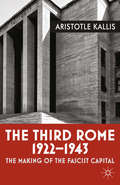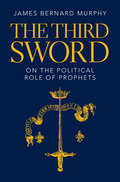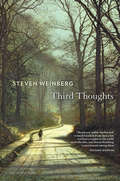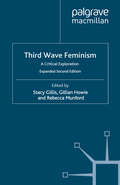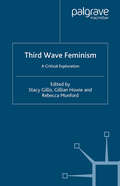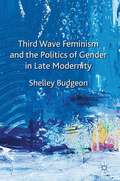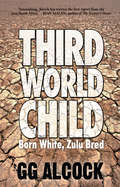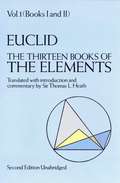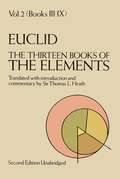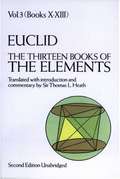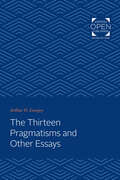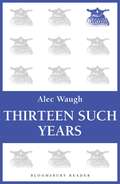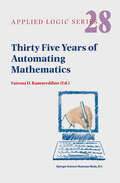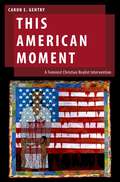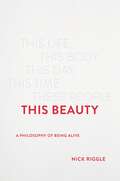- Table View
- List View
The Third Lens: Metaphor and the Creation of Modern Cell Biology
by Andrew S. ReynoldsDoes science aim at providing an account of the world that is literally true or objectively true? Understanding the difference requires paying close attention to metaphor and its role in science. In The Third Lens, Andrew S. Reynolds argues that metaphors, like microscopes and other instruments, are a vital tool in the construction of scientific knowledge and explanations of how the world works. More than just rhetorical devices for conveying difficult ideas, metaphors provide the conceptual means with which scientists interpret and intervene in the world. Reynolds here investigates the role of metaphors in the creation of scientific concepts, theories, and explanations, using cell theory as his primary case study. He explores the history of key metaphors that have informed the field and the experimental, philosophical, and social circumstances under which they have emerged, risen in popularity, and in some cases faded from view. How we think of cells—as chambers, organisms, or even machines—makes a difference to scientific practice. Consequently, an accurate picture of how scientific knowledge is made requires us to understand how the metaphors scientists use—and the social values that often surreptitiously accompany them—influence our understanding of the world, and, ultimately, of ourselves. The influence of metaphor isn’t limited to how we think about cells or proteins: in some cases they can even lead to real material change in the very nature of the thing in question, as scientists use technology to alter the reality to fit the metaphor. Drawing out the implications of science’s reliance upon metaphor, The Third Lens will be of interest to anyone working in the areas of history and philosophy of science, science studies, cell and molecular biology, science education and communication, and metaphor in general.
The Third Lens: Metaphor and the Creation of Modern Cell Biology
by Andrew S. ReynoldsDoes science aim at providing an account of the world that is literally true or objectively true? Understanding the difference requires paying close attention to metaphor and its role in science. In The Third Lens, Andrew S. Reynolds argues that metaphors, like microscopes and other instruments, are a vital tool in the construction of scientific knowledge and explanations of how the world works. More than just rhetorical devices for conveying difficult ideas, metaphors provide the conceptual means with which scientists interpret and intervene in the world. Reynolds here investigates the role of metaphors in the creation of scientific concepts, theories, and explanations, using cell theory as his primary case study. He explores the history of key metaphors that have informed the field and the experimental, philosophical, and social circumstances under which they have emerged, risen in popularity, and in some cases faded from view. How we think of cells—as chambers, organisms, or even machines—makes a difference to scientific practice. Consequently, an accurate picture of how scientific knowledge is made requires us to understand how the metaphors scientists use—and the social values that often surreptitiously accompany them—influence our understanding of the world, and, ultimately, of ourselves. The influence of metaphor isn’t limited to how we think about cells or proteins: in some cases they can even lead to real material change in the very nature of the thing in question, as scientists use technology to alter the reality to fit the metaphor. Drawing out the implications of science’s reliance upon metaphor, The Third Lens will be of interest to anyone working in the areas of history and philosophy of science, science studies, cell and molecular biology, science education and communication, and metaphor in general.
The Third Lens: Metaphor and the Creation of Modern Cell Biology
by Andrew S. ReynoldsDoes science aim at providing an account of the world that is literally true or objectively true? Understanding the difference requires paying close attention to metaphor and its role in science. In The Third Lens, Andrew S. Reynolds argues that metaphors, like microscopes and other instruments, are a vital tool in the construction of scientific knowledge and explanations of how the world works. More than just rhetorical devices for conveying difficult ideas, metaphors provide the conceptual means with which scientists interpret and intervene in the world. Reynolds here investigates the role of metaphors in the creation of scientific concepts, theories, and explanations, using cell theory as his primary case study. He explores the history of key metaphors that have informed the field and the experimental, philosophical, and social circumstances under which they have emerged, risen in popularity, and in some cases faded from view. How we think of cells—as chambers, organisms, or even machines—makes a difference to scientific practice. Consequently, an accurate picture of how scientific knowledge is made requires us to understand how the metaphors scientists use—and the social values that often surreptitiously accompany them—influence our understanding of the world, and, ultimately, of ourselves. The influence of metaphor isn’t limited to how we think about cells or proteins: in some cases they can even lead to real material change in the very nature of the thing in question, as scientists use technology to alter the reality to fit the metaphor. Drawing out the implications of science’s reliance upon metaphor, The Third Lens will be of interest to anyone working in the areas of history and philosophy of science, science studies, cell and molecular biology, science education and communication, and metaphor in general.
The Third Lens: Metaphor and the Creation of Modern Cell Biology
by Andrew S. ReynoldsDoes science aim at providing an account of the world that is literally true or objectively true? Understanding the difference requires paying close attention to metaphor and its role in science. In The Third Lens, Andrew S. Reynolds argues that metaphors, like microscopes and other instruments, are a vital tool in the construction of scientific knowledge and explanations of how the world works. More than just rhetorical devices for conveying difficult ideas, metaphors provide the conceptual means with which scientists interpret and intervene in the world. Reynolds here investigates the role of metaphors in the creation of scientific concepts, theories, and explanations, using cell theory as his primary case study. He explores the history of key metaphors that have informed the field and the experimental, philosophical, and social circumstances under which they have emerged, risen in popularity, and in some cases faded from view. How we think of cells—as chambers, organisms, or even machines—makes a difference to scientific practice. Consequently, an accurate picture of how scientific knowledge is made requires us to understand how the metaphors scientists use—and the social values that often surreptitiously accompany them—influence our understanding of the world, and, ultimately, of ourselves. The influence of metaphor isn’t limited to how we think about cells or proteins: in some cases they can even lead to real material change in the very nature of the thing in question, as scientists use technology to alter the reality to fit the metaphor. Drawing out the implications of science’s reliance upon metaphor, The Third Lens will be of interest to anyone working in the areas of history and philosophy of science, science studies, cell and molecular biology, science education and communication, and metaphor in general.
The Third Person
by Roberto EspositoAll discourses aimed at asserting the value of human life as such—whether philosophical, ethical, or political—assume the notion of personhood as their indispensable point of departure. This is all the more true today. In bioethics, for example, Catholic and secular thinkers may disagree on what constitutes a person and its genesis, but they certainly agree on its decisive importance: human life is considered to be untouchable only when based on personhood. In the legal sphere as well the enjoyment of subjective rights continues to be increasingly linked to the qualification of personhood, which appears to be the only one capable of bridging the gap between human being and citizen, right and life, and soul and body opened up at the very origins of Western civilization. The radical and alarming thesis put forward in this book is that the notion of person is unable to bridge this gap because it is precisely what creates this breach. Its primary effect is to create a separation in both the human race and the individual between a rational, voluntary part endowed with particular value and another, purely biological part that is thrust by the first into the inferior dimension of the animal or the thing. In opposition to the performative power of the person, whose dual origins can be traced back to ancient Rome and Christianity, Esposito pursues his strikingly original and innovative philosophical inquiry by inviting reflection on the category of the impersonal: the third person, in removing itself from the exclusionary mechanism of the person, points toward the orginary unity of the living being.
Third-Person Self-Knowledge, Self-Interpretation, and Narrative (Contributions To Phenomenology #96)
by Patrizia Pedrini Julie KirschThis volume answers questions that lead to a clearer picture of third-person self- knowledge, the self-interpretation it embeds, and its narrative structure. Bringing together current research on third-person self-knowledge and self-interpretation, the book focuses on third-person self-knowledge, and the role that narrative and interpretation play in acquiring it. It regards the third-personal epistemic approach to oneself as a problem worthy of investigation in its own right, and makes clear the relation between third-person self-knowledge, self-interpretation, and narrative capacities. In recent years, the idea that each person is in a privileged position to acquire knowledge about her own mental states has come under attack. A growing body of empirical research has cast doubt upon the existence of what philosophers call ‘first person self-knowledge’, i.e., knowledge about our mental states that is often thought to be immediate, transparent, and authoritative. This line of thought has led some philosophers to claim that what seems to be ‘first-person self-knowledge’ is really just ‘third-person self-knowledge,’ i.e., knowledge about our mental states that is inferential, opaque, and fallible. This book discusses challenges for first-person knowledge and explores the true nature of third-person knowledge.
The Third Rome, 1922-43: The Making of the Fascist Capital
by Aristotle KallisWhat kind of city was the Fascist 'third Rome'? Imagined and real, rooted in the past and announcing a new, 'revolutionary' future, Fascist Rome was imagined both as the ideal city and as the sacred centre of a universal political religion. Kallis explores this through a journey across the sites, monuments, and buildings of the fascist capital.
Third Thoughts
by Steven WeinbergOne of the world’s most captivating scientists challenges us to think about nature’s foundations and the entanglement of science and society. Steven Weinberg, author of The First Three Minutes, offers his views on fascinating aspects of physics and the universe, but does not seclude science behind disciplinary walls, or shy away from politics.
Third Thoughts
by Steven WeinbergOne of the world’s most captivating scientists challenges us to think about nature’s foundations and the entanglement of science and society. Steven Weinberg, author of The First Three Minutes, offers his views on fascinating aspects of physics and the universe, but does not seclude science behind disciplinary walls, or shy away from politics.
Third Wave Feminism: A Critical Exploration
by S. Gillis G. Howie R. MunfordThis revised and expanded edition, new in paperback, provides a definitive collection on the current period in feminism known by many as the 'third wave'. Three sections - genealogies and generations, locales and locations, politics and popular culture - interrogate the wave metaphor and, through questioning the generational account of feminism, indicate possible future trajectories for the feminist movement. New to this edition are an interview with Luce Irigaray, a foreword by Imelda Whelehan as well as newly commissioned chapters.
Third Wave Feminism: A Critical Exploration
by S. Gillis G. Howie R. MunfordThis revised and expanded edition, new in paperback, provides a definitive collection on the current period in feminism known by many as the 'third wave'. Three sections - genealogies and generations, locales and locations, politics and popular culture - interrogate the wave metaphor and, through questioning the generational account of feminism, indicate possible future trajectories for the feminist movement. New to this edition are an interview with Luce Irigaray, a foreword by Imelda Whelehan as well as newly commissioned chapters.
Third-Wave Feminism and the Politics of Gender in Late Modernity
by S. BudgeonThis book critically assessesthird-wave feminist strategies for advancing a feminist 'politics of the self' within the late modern, postfeminist gender order – a context where gender equality has been mainstreamed, feminism has been dismissed, and a neoliberal culture of self-management has become firmly entrenched.
Third World Child: Born White, Zulu Bred
by GG AlcockGG Alcock's parents, Creina and Neil, were humanitarians who gave up comfortable lives to move to rural Zululand. In a place called Msinga, a dry rock-strewn wilderness and one of the most violent places in Africa, they lived and worked among the Mchunu and Mthembu tribes, fighting for the rights of people displaced by the apartheid government's policy of "forced removals". They also fought against the corruption of police and government officials, as well as local farmers, which did not sit well with their white fellow citizens. When GG was fourteen his father was assassinated by rival tribesmen. GG's early life in rural Zululand in the 1970s and 80s can only be described as unique. He and his brother Khonya, both initially home-schooled by their mother, grew up as Zulu kids, herding goats and playing with the children of their neighbours, learning to speak fluent Zulu, learning to become Zulu men under the guidance of Zulu elders, and learning the customs and history of their adopted tribes. Armed with their father's only legacy - the skills to survive in Africa - both young men were ultimately forced to move into the "white" world which was largely unknown to them. In many ways, GG Alcock's story mirrors that of many of his people, the journey of a tribal society learning to embrace the first world. He does not shy away from the violence and death that coloured his childhood years surrounded by savage faction fighting, nor how they affected his adult life. His story in Third World Child is one of heartbreak and tragedy and, paradoxically, of vibrant hope and compassion. A restless energy and sardonic humour permeate his writing, which is compelling in its honesty and spontaneity.
The Thirteen Books of the Elements (Dover Books on Mathematics #1)
by EuclidThis is the definitive edition of one of the very greatest classics of all time — the full Euclid, not an abridgement. Using the text established by Heiberg, Sir Thomas Heath encompasses almost 2,500 years of mathematical and historical study upon Euclid.This unabridged republication of the original enlarged edition contains the complete English text of all 13 books of the Elements, plus a critical apparatus that analyzes each definition, postulate, and proposition in great detail. It covers textual and linguistic matters; mathematical analyses of Euclid’s ideas; classical, medieval, Renaissance, modern commentators; refutations, supports, extrapolations, reinterpretations, and historical notes, all given with extensive quotes.“The textbook that shall really replace Euclid has not yet been written and probably never will be.” — Encyclopaedia Britannica.Volume 1. 151-page Introduction: life and other works of Euclid; Greek and Islamic commentators; surviving mss., scholia, translations; bases of Euclid’s thought. Books I and II of the Elements, straight lines, angles, intersection of lines, triangles, parallelograms, etc.
The Thirteen Books of the Elements: Books Iii-ix (classic Reprint) (Dover Books on Mathematics #2)
by EuclidThis is the definitive edition of one of the very greatest classics of all time — the full Euclid, not an abridgement. Using the text established by Heiberg, Sir Thomas Heath encompasses almost 2,500 years of mathematical and historical study upon Euclid.This unabridged republication of the original enlarged edition contains the complete English text of all 13 books of the Elements, plus a critical apparatus that analyzes each definition, postulate, and proposition in great detail. It covers textual and linguistic matters; mathematical analyses of Euclid’s ideas; classical, medieval, Renaissance, modern commentators; refutations, supports, extrapolations, reinterpretations, and historical notes, all given with extensive quotes. Volume 1. 151-page Introduction: life and other works of Euclid; Greek and Islamic commentators; surviving mss., scholia, translations; bases of Euclid’s thought. Books I and II of the Elements, straight lines, angles, intersection of lines, triangles, parallelograms, etc.Volume 2. Books III-IX: Circles, tangents, segments, figures described around and within circles, rations, proportions, magnitudes, polygons, prime numbers, products, plane and solid numbers, series of rations, etc.Volume 3. Books X to XIII: planes, solid angles, etc.; method of exhaustion in similar polygons within circles, pyramids, cones, cylinders, spheres, etc. Appendix: Books XIV, XV, sometimes ascribed to Euclid.
The Thirteen Books of the Elements, Vol. 3 (Dover Books on Mathematics #3)
by EuclidThis is the definitive edition of one of the very greatest classics of all time—the full Euclid, not an abridgement. Utilizing the text established by Heiberg, Sir Thomas Heath encompasses almost 2500 years of mathematical and historical study upon Euclid.This unabridged republication of the original enlarged edition contains the complete English text of all 13 books of the Elements, plus a critical apparatus which analyzes each definition, postulate, and proposition in great detail. It covers textual and linguistic matters; mathematical anayses of Euclid's ideas; classical, medieval, Renaissance, modern commentators; refutations, supports, extrapolations, reinterpretations, and historical notes, all given with extensive quotes.
The Thirteen Pragmatisms and Other Essays
by Arthur O. LovejoyThe essays in this volume are critical and, with one exception, directed against the philosophic movement of pragmatism. "The Thirteen Pragmatisms" is an exercise in logical analysis and is a challenge to a group of philosophers who have taken on a collective name to show how their apparent diversities are to be reconciled. Few philosophers would call themselves orthodox followers of this train of thought, so these essays can be studied without a sense of personal injury that deadens the critical faculty and obscures insight. In these essays, logical technique is on display: the author's keenness in spotting double meanings and his ability to rephrase them in univalent form. This collection of essays should afford students of philosophy a set of cases in which they need not take sides but which give them an analytical method they can practice themselves on contemporary issues. The fact that these essays are on the whole critical gives them a heuristic value that dogmatic or expository essays would not have.
The Thirteen Pragmatisms and Other Essays
by Arthur O. LovejoyOriginally published in 1963. The essays in this volume are critical and, with one exception, directed against the philosophic movement of pragmatism. "The Thirteen Pragmatisms" is an exercise in logical analysis and is a challenge to a group of philosophers who have taken on a collective name to show how their apparent diversities are to be reconciled. Few philosophers would call themselves orthodox followers of this train of thought, so these essays can be studied without a sense of personal injury that deadens the critical faculty and obscures insight. In these essays, logical technique is on display: the author's keenness in spotting double meanings and his ability to rephrase them in univalent form. This collection of essays should afford students of philosophy a set of cases in which they need not take sides but which give them an analytical method they can practice themselves on contemporary issues. The fact that these essays are on the whole critical gives them a heuristic value that dogmatic or expository essays would not have.
The Thirteen Pragmatisms and Other Essays
by Arthur O. LovejoyOriginally published in 1963. The essays in this volume are critical and, with one exception, directed against the philosophic movement of pragmatism. "The Thirteen Pragmatisms" is an exercise in logical analysis and is a challenge to a group of philosophers who have taken on a collective name to show how their apparent diversities are to be reconciled. Few philosophers would call themselves orthodox followers of this train of thought, so these essays can be studied without a sense of personal injury that deadens the critical faculty and obscures insight. In these essays, logical technique is on display: the author's keenness in spotting double meanings and his ability to rephrase them in univalent form. This collection of essays should afford students of philosophy a set of cases in which they need not take sides but which give them an analytical method they can practice themselves on contemporary issues. The fact that these essays are on the whole critical gives them a heuristic value that dogmatic or expository essays would not have.
Thirteen Such Years
by Alec WaughIn the manner and method of Hot Countries and Most Women, in which personal narrative and opinion are woven together with fiction, Mr. Waugh travels through a period and brilliantly pictures the post-war times and tries to explain what has happened to the war generation. He shows a topsy-turvy world. He tells anecdotes and stories with his unfailing charm. He has been courageous in his deductions and provocative in his suggestions as he turns from physical travel to spiritual interpretation.
Thirty Five Years of Automating Mathematics (Applied Logic Series #28)
by F. D. KamareddineTHIRTY FIVE YEARS OF AUTOMATING MATHEMATICS: DEDICATED TO 35 YEARS OF DE BRUIJN'S AUTOMATH N. G. de Bruijn was a well established mathematician before deciding in 1967 at the age of 49 to work on a new direction related to Automating Mathematics. By then, his contributions in mathematics were numerous and extremely influential. His book on advanced asymptotic methods, North Holland 1958, was a classic and was subsequently turned into a book in the well known Dover book series. His work on combinatorics yielded influential notions and theorems of which we mention the de Bruijn-sequences of 1946 and the de Bruijn-Erdos theorem of 1948. De Bruijn's contributions to mathematics also included his work on generalized function theory, analytic number theory, optimal control, quasicrystals, the mathematical analysis of games and much more. In the 1960s de Bruijn became fascinated by the new computer technology and as a result, decided to start the new AUTOMATH project where he could check, with the help of the computer, the correctness of books of mathematics. In each area that de Bruijn approached, he shed a new light and was known for his originality and for making deep intellectual contributions. And when it came to automating mathematics, he again did it his way and introduced the highly influential AUTOMATH. In the past decade he has also been working on theories of the human brain.
This American Moment: A Feminist Christian Realist Intervention (Oxford Studies in Gender and International Relations)
by Caron E. GentryAccording to this book, the United States is currently in a moment of crisis, fomented by anxieties around race and gender politics. Unlike fear, which is usually focused on a particular object, anxiety is indeterminate and uncertain. It is also the emotion that led to the election and continued support of President Trump. But Caron Gentry says that we can deal with this anxiety in a productive way. To do so, she turns to Reinhold Niebuhr, whose philosophy of Christian realism has been an abiding influence on foreign policy since the Cold War. According to Niebuhr "Man's capacity for justice makes democracy possible; but man's inclination to injustice makes democracy necessary." Anxiety is central to Niebuhr's ideas: an emotion that is abiding because we lack control over the circumstances of our lives. In turn, anxiety prompts a desire for unity, but also an intolerance for difference. Niebuhr suggests that anxiety can be dealt with destructively or creatively, and that power must be balanced to prevent destructive action. Gentry is critical of Niebuhr, saying that he gives in to destructive tendencies in humans by elevating power above other, more creative solutions. In This American Moment, she offers feminist Christian realism as an alternate approach to anxiety in international politics. Gentry's feminist Christian realism differentiates itself from Niebuhr's Christian realism by re-engaging the importance of love and relationships over power. It suggests that we can arrive at creative solutions to anxiety through a conversation about the imago dei and the inherent commitments to community borne of one's relationship with God, including the recognition of obligation in the face of vulnerability. Throughout Gentry applies her ideas to the problems of police brutality, women's reproductive health, and the rise in fascist politics.
This American Moment: A Feminist Christian Realist Intervention (Oxford Studies in Gender and International Relations)
by Caron E. GentryAccording to this book, the United States is currently in a moment of crisis, fomented by anxieties around race and gender politics. Unlike fear, which is usually focused on a particular object, anxiety is indeterminate and uncertain. It is also the emotion that led to the election and continued support of President Trump. But Caron Gentry says that we can deal with this anxiety in a productive way. To do so, she turns to Reinhold Niebuhr, whose philosophy of Christian realism has been an abiding influence on foreign policy since the Cold War. According to Niebuhr "Man's capacity for justice makes democracy possible; but man's inclination to injustice makes democracy necessary." Anxiety is central to Niebuhr's ideas: an emotion that is abiding because we lack control over the circumstances of our lives. In turn, anxiety prompts a desire for unity, but also an intolerance for difference. Niebuhr suggests that anxiety can be dealt with destructively or creatively, and that power must be balanced to prevent destructive action. Gentry is critical of Niebuhr, saying that he gives in to destructive tendencies in humans by elevating power above other, more creative solutions. In This American Moment, she offers feminist Christian realism as an alternate approach to anxiety in international politics. Gentry's feminist Christian realism differentiates itself from Niebuhr's Christian realism by re-engaging the importance of love and relationships over power. It suggests that we can arrive at creative solutions to anxiety through a conversation about the imago dei and the inherent commitments to community borne of one's relationship with God, including the recognition of obligation in the face of vulnerability. Throughout Gentry applies her ideas to the problems of police brutality, women's reproductive health, and the rise in fascist politics.
This Beauty: A Philosophy of Being Alive
by Nick RiggleAn acclaimed philosopher and new father argues that engaging with beauty can make life worth living You didn&’t choose to live this life, in this body, in these conditions—this delicate and difficult life. Yet when you consider that your existence is fleeting, an inspired sense of urgency can spring forth. Say you often hike with a friend. One day, they propose that you skydive instead. You&’re wavering, and they insist: Come on. You only live once! And soon you&’re flying through the air. Why embrace a life you did not choose? In This Beauty, philosopher Nick Riggle explores the beauty of being alive by investigating the things we say to inspire ourselves and each other: seize the day, treat yourself, you only live once. These clichés are at best vague, at worst stupid. They imply that you should do something wild with your life because your life is precious, a little like saying you should go swimming with your grandfather&’s watch because it is irreplaceable. Drawing on insights from aesthetics and his experiences as a professional skater and new father, he develops the thought that beauty—the beauty of this day, this body, this moment, these people—can make life worth embracing, worth engaging with and amplifying as beautiful. Insightful and deeply humane, This Beauty is a searching inquiry into the mystery of life&’s beauty and a call to create and share it.
